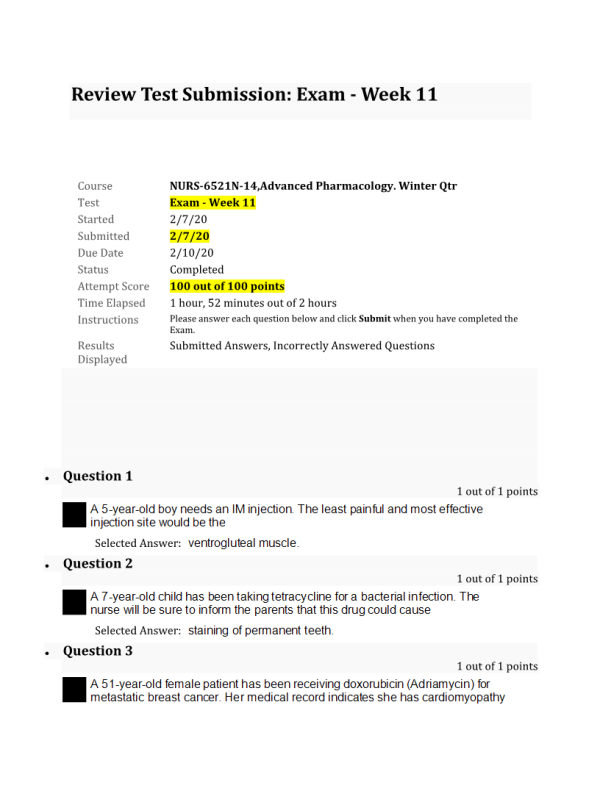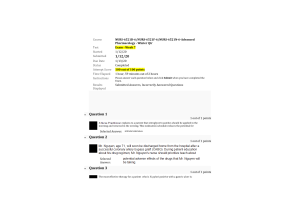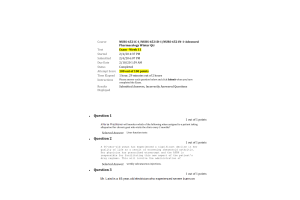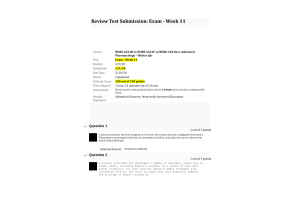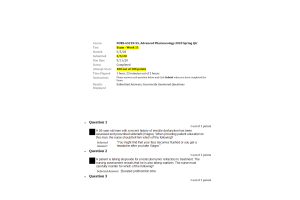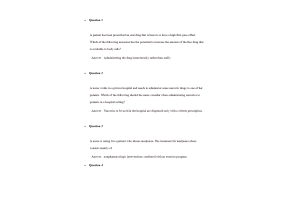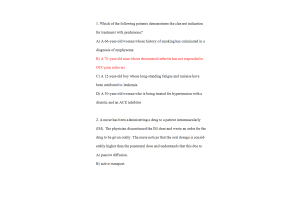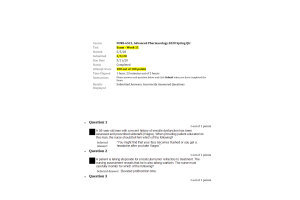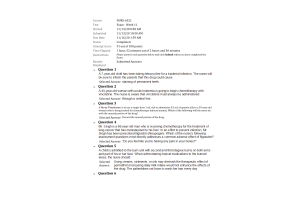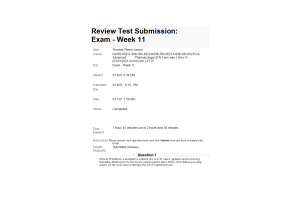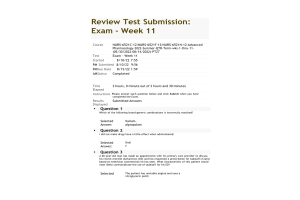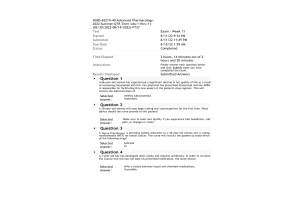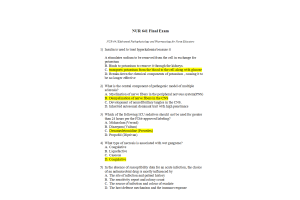NURS 6521N-14, Week 11 Final Exam100 out of 100 Points
- $49.00
- Question: A 5-year-old boy needs an IM injection. The least painful and most effective injection site would be the
- Question: A 7-year-old child has been taking tetracycline for a bacterial infection. The nurse will be sure to inform the parents that this drug could cause
- Question: A 51-year-old female patient has been receiving doxorubicin (Adriamycin) for metastatic breast cancer. Her medical record indicates she has cardiomyopathy and a cumulative dose of 300 mg/m2 of doxorubicin. Which of the following measures would help limit the severity of the cardiomyopathy in this patient?
- Question: A patient with non-Hodgkin's lymphoma (NHL) will be starting a course of doxorubicin shortly. When planning this patient's care, what nursing diagnosis should the nurse prioritize?
- Question: A Nurse Practitioner is performing patient education for a woman who has just been prescribed a bisphosphonate. Which of the following diagnostic and history findings would have prompted the woman's care provider to prescribe a bisphosphonate?
- Question: A 13-year-old patient has juvenile arthritis. He has recently had oral surgery and was told by the surgeon to take aspirin for the pain. The APRN will monitor for which of the following?
- Question: The recommended treatment for trichomoniasis is
- Question: A Nurse Practitioner educator who coordinates the staff education on an oncology unit is conducting an inservice on targeted therapies. What potential benefit of targeted therapies should the nurse highlight in this education session?
- Question: An oncology nurse is aware of the risks for injury that exist around the preparation, transportation, and administration of chemotherapeutic agents. In order to reduce these risks of injury, the nurse should take which of the following actions?
- Question: A patient has been prescribed oral tetracycline. The nurse will instruct the patient to take the drug
- Question: A 16-year-old boy is prescribed cromolyn sodium nasal spray to treat a nasal allergy. To maximize the therapeutic effects of the drug, which of the following will the nurse include in instructions to the patient?
- Question: An elderly woman is slated for a hemiarthroplasty (hip replacement surgery) after falling and breaking her hip on the stairs outside her home. The woman's pain in the time since her injury has been severe, and her care team has been treating it with morphine. Which of the following administration schedules is most likely to control the patient's pain?
- Question: A Nurse Practitioner is obtaining baseline physical data from a 7-year-old patient who is to be started on dextroamphetamine for ADHD. After obtaining vital signs, height, and weight, the nurse will prepare the patient for an
- Question: An immunocompromised 7-year-old child was recently discharged home with a peripherally-inserted central line (PIC line) for home antibiotic therapy. He has now been brought to the emergency department by his mother and father with signs and symptoms of line sepsis. Upon questioning, the mother states that she has been removing the PIC dressing daily and washing the site with warm water and a cloth. What nursing diagnosis is most appropriate in this situation?
- Question: A 65-year-old woman has an advanced form of rheumatoid arthritis. Her treatment includes a regular dosage of methotrexate. The APRN will advise her to take which of the following vitamin supplements while taking the drug?
- Question: A nurse practitioner has been assigned to a 55-year-old woman who has a malignant brain tumor. The patient is receiving her first dose of carmustine. It will be critical for the nurse to observe for which of the following?
- Question: A 45-year-old female patient is prescribed ciprofloxacin to treat a bronchial infection. A nursing assessment revealed that she started taking daily vitamin supplements about 2 years ago. To maximize the therapeutic effects of the ciprofloxacin therapy, the nurse should advise the patient to
- Question: Morphine has been prescribed for a 28-year-old man with severe pain due to a back injury. The nurse will advise the patient to avoid
- Question: A Nurse Practitioner is assessing a patient who has chronic lymphoblastic myelogenous leukemia. The treatment plan includes hydroxyurea (Hydrea). The nurse will assess the patient for which of the following?
- Question: A 7-year-old child has tonsillitis and is prescribed penicillin V, which is to be administered at home. The nurse will instruct the parents to administer the drug
- Question: A patient is taking etoposide for a testicular tumor refractory to treatment. The nursing assessment reveals that he is also taking warfarin. The nurse must carefully monitor for which of the following?
- Question: A Nurse Practitioner is providing patient education to a 13-year-old girl who was just diagnosed with type 1 diabetes mellitus. Which of the following statements by the patient will alert the nurse that special instructions regarding insulin are necessary?
- Question: A patient has acquired primary hypogonadism and has been prescribed testosterone transdermal (Androderm) patches. When educating the patient on how to administer the drug, the nurse will instruct him to
- Question: A child is admitted to the burn unit with second and third degree burns on both arms and part of his or her face. When administering topical medications to the burned areas, the nurse should
- Question: A child is taking permethrin for head lice. The Nurse Practitioner will instruct her mother to
- Question: A 60-year-old patient experienced a sudden onset of chest pain and shortness of breath and was subsequently diagnosed with a pulmonary embolism in the emergency department. The patient has been started on an intravenous heparin infusion. How does this drug achieve therapeutic effect?
- Question: The Nurse Practitioner notices a cold sore on a patient's upper lip and requests medication; docosanol (Abreva) is ordered. Before applying the medication, the nurse would first
- Question: A 9-year-old boy was bought to his primary care provider by his mother with signs and symptoms of hookworm infection and will be sent home with a prescription for mebendazole. When provided patient and family education, the nurse should teach the mother with which of the following measures to avoid reinfection following treatment?
- Question: A patient has been admitted to the critical care unit of the hospital with bacterial septicemia that has failed to respond to initial antibiotic treatment. The patient's most recent blood cultures reveal the presence of methicillin-resistant Staphylococcus aureus (MRSA) in the patient's blood. The nurse will anticipate that this patient will likely require intravenous administration of what antibiotic?
- Question: An older adult woman has been diagnosed with acute lymphoblastic leukemia (ALL) and her care team has identified potential benefits of imatinib. Which of the following characteristics of this patient's current health status may preclude the use of imatinib?
- Question: A patient is taking rifampin (Rifadin) for active TB. When discussing this drug with the patient, the nurse should stress that
- Question: Which of the following would a Nurse Practitioner assess for in a patient who is taking polymyxin B systemically?
- Question: A male patient is trying to decide if he should use finasteride (Proscar) to treat benign prostatic hypertrophy (BPH). When providing information about the drug, the nurse will include which of the following as a risk associated with finasteride therapy?
- Question: Alprostadil (Caverject), a drug used to treat erectile dysfunction, has been prescribed to a 42-year-old patient. When providing education to the patient and his wife, the nurse should inform the wife about which of the following adverse effects?
- Question: A Nurse Practitioner is to use a single-dose 1 mL vial to administer 0.5 mL of epoetin alfa to a 39-year-old woman who is being treated for chemotherapy-induced anemia. Which of the following will the nurse do with the unused portion of the drug?
- Question: A 12-year-old boy is being discharged from the hospital after major surgery. The boy will be taking two medications at home for an extended period. The nurse who is discharging the patient should provide medication teaching specifically to
- Question: A Nurse Practitioner works at a weight management clinic. To which of the following overweight patients could the nurse safely administer dextroamphetamine?
- Question: A Nurse Practitioner is caring for a patient who is at 28 weeks' gestation and is receiving terbutaline (Brethine) to control preterm labor. Which of the following assessment parameters should the nurse prioritize?
- Question: A school nurse has been teaching high school students about the risks associated with marijuana use. However, the nurse has been met with considerable skepticism on the part of students, most of whom believe that marijuana is a benign drug. Which of the following teaching points should the nurse provide?
- Question: A 33-year-old man has developed acute gouty arthritis. He has been prescribed colchicine. When developing a care plan for this patient, which factor will be most important for the nurse to consider?
- Question: Sulconazole has been prescribed for a patient with tinea pedis. The nurse will instruct the patient to use the topical agent
- Question: A Nurse Practitioner is going to administer medication to an infant using a medicine dropper. The best method is to open the child's mouth by gently squeezing the cheeks and placing the drops
- Question: A Nurse Practitioner is explaining to the parents of a 6-year-old child suffering from angina why nitroglycerin patches for chest pain would not be appropriate. Which of the following will the nurse include in an explanation?
- Question: A woman is receiving magnesium sulfate for intrapartum eclampsia. The patient is perspiring and her blood pressure is 88/50. The serum magnesium level is 10 mg/dL. The nurse will interpret these manifestations as
- Question: A Nurse Practitioner is explaining to a pregnant 21-year-old college student why she cannot continue to take ibuprofen (Advil) for her headaches. The nurse draws a picture depicting drug molecules crossing the placental membrane and entering into the fetal circulation. The nurse tells the patient that the main reason this happens is because
- Question: A 73-year-old woman has osteoporosis and is prescribed alendronate. She takes calcium and vitamin D supplements, drinks lots of water, and has just quit smoking. The nurse should advise the patient to also
- Question: A male patient has been brought to the emergency department during an episode of status epilepticus. Diazepam is to be administered intravenously. The APRN will be sure to
- Question: A patient with AIDS has developed a number of secondary infections in recent weeks, including Kaposi's sarcoma. As a result of this most recent diagnosis, his care team has opted to begin treatment with interferon alfa-2a. The nurse is aware that this drug will address the etiology of Kaposi sarcoma by
- Question: A 67-year-old man who is being treated for prostate cancer is taking epoetin alfa. The nurse will instruct the patient to
- Question: A 15-year-old patient has meningitis caused by Hemophilus influenzae. She is being treated with chloramphenicol. The most important nursing action for this patient would be to monitor
- Question: An oncology nurse is reviewing the pathophysiology of cancer and is discussing with a colleague the factors that contribute to the success or failure of a patient's chemotherapy. Which of the following cancerous cells is most susceptible to the effects of chemotherapeutic drugs?
- Question: Intravenous carmustine has been prescribed for a patient with cancer. The nurse should help relieve the discomfort of pain and burning during the infusion by
- Question: A Nurse Practitioner is instructing a 19-year-old female patient on the use of fluconazole for candida vaginitis. A teaching priority will be to
- Question: A female patient is taking filgrastim (Neupogen) to decrease the incidence of infection. The nurse notices a small increase in the neutrophil count 2 days after starting therapy. The nurse's evaluation of the increase is that
- Question: Which of the following would the nurse include in a teaching plan about the signs and symptoms of thrombophlebitis and thromboembolism that should be reported by a patient taking estrogen?
- Question: A Nurse Practitioner is explaining the use of acyclovir therapy to a 72-year-old man. Nephrotoxicity is discussed as a major adverse effect in older patients. To minimize the risk of the patient developing this adverse effect, the nurse will advise him to
- Question: An immunocompromised patient in a critical care setting has developed a respiratory infection that has been attributed to methicillin-resistant Staphylococcus aureus (MRSA). The nurse should anticipate that the patient will require treatment with
- Question: A patient is receiving radiotherapy for an overactive thyroid gland and asks whether her milk is safe for her baby. If her treatment cannot be discontinued, what should the nurse recommend?
- Question: A Nurse Practitioner is working with a 16-year-old pregnant teen and assessing for behavior that may put the baby at risk. The most important assessment the nurse can make is
- Question: The nurse practitioner orders Amoxicillin 500 mg tid? What is the total amount of medication patient will take per day?
- Question: A Nurse Practitioner who provides care on a pediatric unit of a hospital is aware that the potential for harm as a result of drug errors is higher among infants and children than adults. This fact is primarily due to
- Question: A man is prescribed ciprofloxacin to treat a sexually transmitted infection. The nurse will instruct the patient to
- Question: Mr. Singh is a 66-year-old man who is receiving chemotherapy for the treatment of lung cancer that has metastasized to his liver. In an effort to prevent infection, Mr. Singh has been prescribed filgrastim (Neupogen). Which of the nurse's following assessment questions most directly addresses a common adverse effect of filgrastim?
- Question: Mr. Laird is a 49-year-old electrician who experienced severe burns on his trunk, arms, and hands in a workplace accident 2 weeks ago. Part of his current wound care regimen involves the daily application of silver sulfadiazine to his wounds. The nurses who are providing care for Mr. Laird in the burns and plastics unit of the hospital should perform what action when administering this medication?
- Question: The Nurse Practitioner has established peripheral IV access and begun an infusion of magnesium sulfate on a 29-year-old antepartum patient who is 35 weeks pregnant. Which of the following assessment findings most likely prompted the patient's physician to order magnesium sulfate for this patient?
- Question: A 66-year-old woman has experienced a significant decline in her quality of life as a result of worsening rheumatoid arthritis. Her physician has prescribed etanercept and the APRN is responsible for facilitating this new aspect of the patient's drug regimen. This will involve the administration of
- Question: A Nurse Practitioner will monitor which of the following when assigned to a patient taking allopurinol for chronic gout who visits the clinic every 2 months?
- Question: Mr. Lepp is a 63-year-old man who was diagnosed with colon cancer several weeks ago and who is scheduled to begin chemotherapy. He reports to the nurse that he read about the need for erythropoietin in an online forum for cancer patients and wants to explore the use of epoetin alfa with his oncologist. Which of the following facts should underlie the nurse's response to Mr. Lepp?
- Question: A 46-year-old man is receiving a quinupristin/dalfopristin IV infusion for a life-threatening infection. Which of the following would be most important for the nurse to monitor?
- Question: A patient asks the nurse practitioner about food sources such as soybeans and soy products. The nurse practitioner understands that these foods are considered
- Question: A Nurse Practitioner is caring for a patient with cancer who has been prescribed dronabinol (Marinol) to help reduce nausea and vomiting from chemotherapy. The nurse will inform the patient that he or she is taking an oral form of
- Question: A 43-year-old man has been diagnosed with active TB. He is prescribed a multiple drug therapy, including INH and rifampin. A priority assessment by the nurse will be to monitor which combination of
- Question: A patient has been admitted to the critical care unit with a diagnosis of peritonitis that has necessitated treatment with gentamicin. As a result, the care team should be cautious when concurrently administering other medications that may cause
- Question: A 30-year-old African-American woman tested positive for TB and is prescribed isoniazid. The nurse will plan the patient's care to include close monitoring of the drug therapy because
- Question: A 35-year-old woman is on a weight-loss program and is to begin taking sibutramine (Meridia). After baseline physical data are obtained, the nurse will assess the patient's childbearing potential. The nurse will inform the patient that during sibutramine therapy she should
- Question: A male patient is taking finasteride for BPH. Which of the following will the nurse evaluate at each clinic visit?
- Question: A 15-year-old boy who has been taking dextroamphetamine for the treatment of ADHD has been experiencing a depressed mood and a sense of hopelessness. He confides in the school nurse that he has begun taking his stepfather's antidepressant to improve his mood. After immediately phoning the boy's stepfather, the nurse learns that the drug in question is phenelzine (Nardil), a monoamine oxidase inhibitor (MAOI). The nurse should recognize that this combination of drugs creates a serious risk of what health problem?
- Question: A 13-year-old female took a weight loss drug that activated the sympathetic nervous system. Which of the following assessment findings would the nurse expect?
- Question: A 2-year-old child is diagnosed with a minor ailment and is to be administered medications at home for 2 weeks. The child lives with his mother, grandmother, and four other children between the ages of 14 months and 7 years. The home health nurse is asked to assess the home environment to determine if it is appropriate for the child to take his medication at home. Which of the following will have the greatest impact on the nurse's assessment?
- Question: A woman who is in the second trimester of her first pregnancy has been experiencing frequent headaches and has sought advice from her nurse practitioner about safe treatment options. What analgesic can the nurse most safely recommend?
- Question: A pregnant patient asks the Nurse Practitioner what over-the-counter medication she can take for recurring headaches. The nurse should recommend
- Question: Alendronate (Fosamax) is prescribed for a 67-year-old postmenopausal woman. In order to help prevent gastrointestinal distress, the nurse will advise the patient to
- Question: A nurse practitioner orders a single dose of 2 g Metronidazole orally. How many milligrams will the patient receive in one dose?
- Question: A 20-year-old female patient is receiving topical clindamycin for acne vulgaris. She develops a rash and urticaria along with severe itching where the medication is applied. The nurse will formulate which of the following nursing diagnoses for the patient?
- Question: A patient has completed 4 weeks of treatment with epoetin alfa. Which of the following assessment findings would most strongly indicate that treatment has been effective?
- Question: An immunocompromised patient with a diagnosis of candidiasis has failed to respond to conservative therapy and has consequently begun treatment with amphotericin B. The nurse is aware that this drug achieves a therapeutic effect by way of its influence on
- Question: A 59-year-old man with a recent history of erectile dysfunction has been assessed and prescribed sildenafil (Viagra). When providing patient education to this man, the nurse should tell him which of the following?
- Question: A 66-year-old man has made an appointment with his primary care provider to discuss his recent erectile dysfunction (ED) and has requested a prescription for tadalafil (Cialis) based on television commercials he has seen. What characteristic of this patient would most likely contraindicate the use of tadalafil for his ED?
- Question: Drugs have a valid medical use but a high potential for abuse, both psychological and physiologic. In an emergency, a Schedule 2 drug may be prescribed by telephone if a written prescription cannot be provided at the time. However, a written prescription must be provided within 72 hours with the words authorization for emergency dispensing written on the prescription. These prescriptions cannot be refilled. A new prescription must be written each time. Examples include certain amphetamines and barbiturates. This is scheduled drug
- Question: A patient with chronic heart failure has begun treatment with epoetin alfa, which she will receive in her own home from a home health nurse. The nurse should teach the patient to supplement this treatment with a diet that is high in
- Question: A postmenopausal patient is prescribed bisphosphonates to treat osteoporosis. The nurse will instruct the patient to take the drug
- Question: A Nurse Practitioner is providing patient education to a 50-year-old woman who is taking methotrexate (MTX) for breast cancer. The nurse will instruct the patient to avoid which of the following drugs?
- Question: A 56-year-old woman will soon begin treatment of her overactive bladder with tolterodine (Detrol). What patient teaching should the nurse provide to this woman?
- Question: Which of the following patients will be at the greatest risk for anemia and would be the most likely candidate for epoetin alfa therapy?
- Question: The clinical nurse educator who oversees the emergency department in a children's hospital has launched an awareness program aimed at reducing drug errors. What measure addresses the most common cause of incorrect doses in the care of infants and children?
- Question: A nurse practitioner orders 150 mg of oral fluconazole for a patient with vulvovaginal candidiasis. The patient should expect to take medication
- Question: A 72-year-old patient is prescribed ophthalmic ciprofloxacin for a bacterial infection in her right eye. The nurse will teach her to observe for which of the following adverse effects of the drug?
- Question: A patient with a recent diagnosis of chronic myelogenous leukemia (CML) is discussing treatment options with his care team. What aspect of the patient's condition would contraindicate the use of cyclophosphamide for the treatment of leukemia?
- Question: A Nurse Practitioner is assigned to a patient who is at 32 weeks' gestation and is receiving terbutaline (Brethine) IV for 24 hours to control preterm labor. Which of the following nursing actions will the nurse take to decrease the risk of hypotension and promote circulation to the fetus?
- Question: A Nurse Practitioner is caring for a 46-year-old female patient who is taking paclitaxel for ovarian cancer. Two or three days after the infusion of the drug, the nurse must closely monitor for which of the following?
- Question: When completing this exam, did you comply with Walden University’s Code of Conduct including the expectations for academic integrity?
